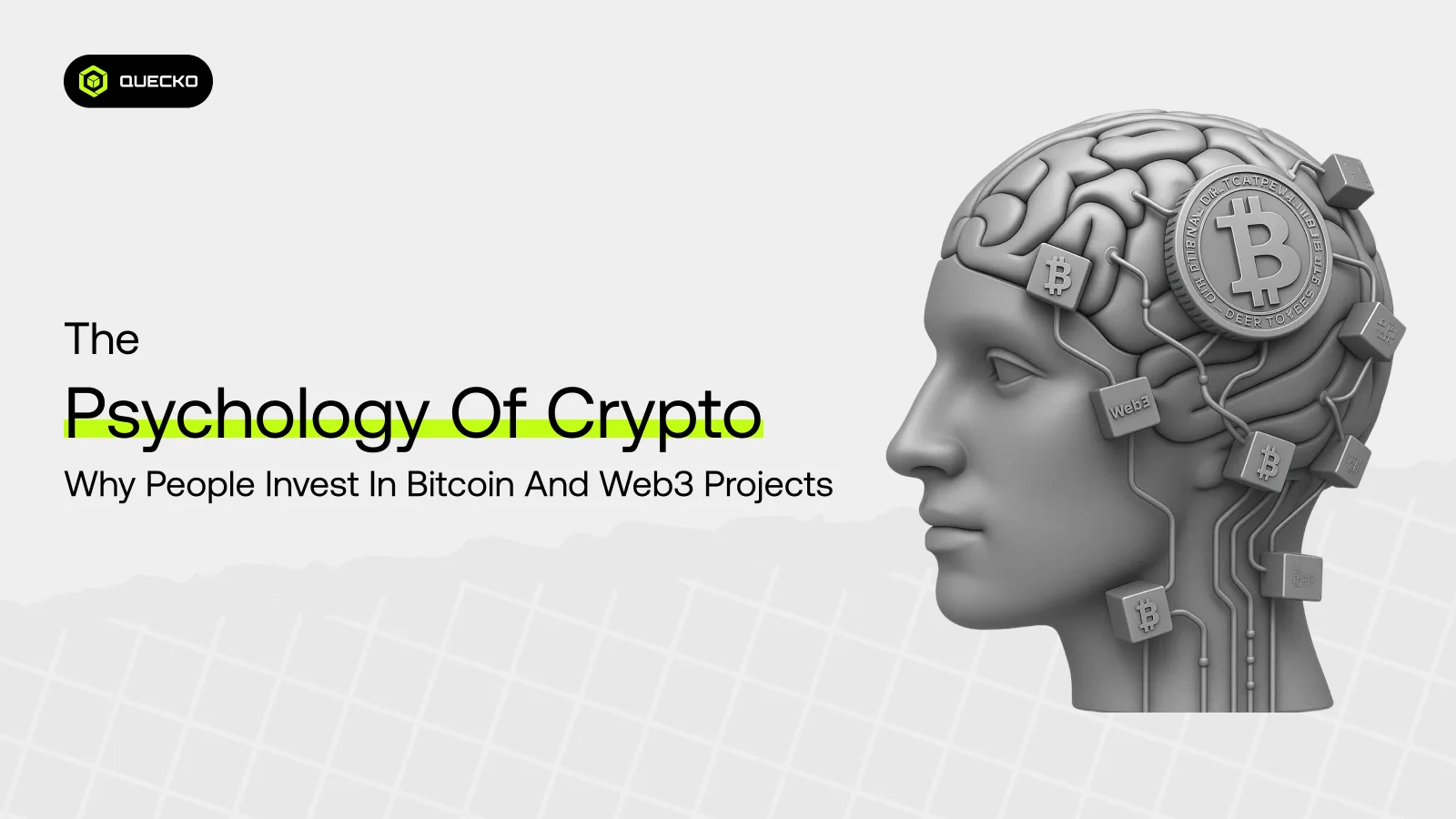Why Web3 Projects Fail: Common Mistakes and How to Avoid Them
Discover why most Web3 projects fail and how to build for long-term success through clear strategy, strong communities, and sustainable tokenomics.

Web3 started as a far-fetched ambition: a decentralized internet where users truly possess their data, assets, and identity. However, while some projects, like Ethereum and Uniswap, perform well, many are wiped out not because of a lack of innovation but due to poor implementation.
At Quecko, we’ve partnered with teams across the blockchain ecosystem, helping launch products with over $500M in combined market capitalization and millions of active users. We’ve seen where projects go right and where they go off course.
Let’s unpack the most common mistakes that lead to Web3 project failure and how teams have overcome them.
Building Without a Clear Problem or Value Proposition
Too many founders enter Web3 with enthusiasm but no clarity. They start coding, minting, or launching tokens without fully understanding what problem they’re solving, or for whom. In an ecosystem as complex and competitive as blockchain, hype without purpose burns out fast.
Chasing Hype Over Utility
It’s easy to get swept up by market cycles, DeFi summer, NFT booms, AI integrations, or the latest Layer 2 trend. But without straightforward utility, projects built purely on hype fade as quickly as they rise.
The only way to gain real traction is by accomplishing concrete tasks: enabling access to finance, fostering creativity on the internet, or preserving user privacy via blockchain technology. It is the teams that are built upon real pain points that survive through business turbulence.
Neglecting Target Audience Needs
Web3 users aren’t a single group. Traders, creators, gamers, and investors all have different motivations and technical comfort levels.
A DeFi protocol with complicated staking features will not attract new participants, and a creator platform lacking token usefulness will not retain artists. By incorporating surveys, user testing, and community feedback early in the product development process, you can define your product-market fit well before launching the product.
At Quecko, we drive projects through the validation of ideas before scaling. Innovation is not based on assumptions but on user needs.
Flawed Tokenomics and Unsustainable Financial Models
The most powerful concept will fail due to poor tokenomics. The economy of a project should be worthy, accountable, and compliant with its mission. Frequently, teams create tokens with short-term speculation rather than long-term.
Designing for Speculation, Not Sustainability
In the case of token demand, whereby trading is the only driver, liquidity will eventually dry up. Sustainable ecosystems offer incentives that balance long-term holders, participation in governance, and provide actual on-chain utility.
Long-term projects implement token systems to improve the health of the ecosystem, including staking rewards based on participation, redistribution of fees, or access to special services.
Mismanaging Digital Assets and Funding
Mismanagement of funds is another silent killer. Some teams overspend during bull runs and struggle when markets cool. Others fail to communicate how funds are allocated, eroding community trust.
Financial transparency, through multi-signature wallets, milestone-based funding, and regular treasury updates, builds confidence. Quecko emphasizes disciplined resource planning to ensure every dollar contributes to long-term resilience.
Neglecting Community and Engagement
In Web3, community isn’t marketing, it’s infrastructure. Your users aren’t customers; they’re stakeholders, ambassadors, and co-builders.
Treating Community as Co-Owners, Not Consumers
The prosperous projects are those in which they engage their community at all stages: governance, beta testing, and feedback loops. DAO formations, Discord surveys, and open proposal systems make members feel like they are part of the game, rather than bystanders.
Hype-Driven Growth Without Retention
Large giveaways and airdrops can inflate numbers, but don’t create loyalty. Real retention comes from education, recognition, and storytelling that aligns users with a shared purpose.
At Quecko, we’ve seen that engagement compounds. Projects that communicate transparently and create consistent participation touchpoints grow stronger over time, even when markets slow.
Technical Debt, Security Vulnerabilities, and Scalability Issues
Behind many failed Web3 projects lies a rushed build, quick deployments, unaudited code, or shortcuts to “go live.” But blockchain has no undo button. Once deployed, vulnerabilities can be exploited permanently.
Smart Contract Risks and Security Flaws
One small coding oversight can lead to millions in losses. Many teams reuse open-source smart contracts without proper security reviews, which can leave backdoors or logic errors.
Best practices include multi-signature wallets, role-based access control, and independent CertiK audits. Modular architectures (like proxy or diamond patterns) also reduce risks by allowing controlled upgrades.
Scalability and Infrastructure Gaps
The usage of Web3 reveals its technical pitfalls: high gas costs, network overload, and low interoperability. The projects that do not consider scalability will frustrate users.
One can plan using Layer 2 solutions, scalable data availability, and gas optimization, which are efficient and ensure scalability without interrupting the experience.
At Quecko, we build architectures designed to evolve, minimizing technical debt while ensuring performance, flexibility, and long-term reliability.
Ineffective Marketing and Misguided Communication
Even great technology fails without straightforward storytelling. If your audience can’t understand your product in one sentence, they won’t explore further.
Too Much Jargon, Too Little Clarity
Terms like “decentralized interoperability” or “modular liquidity layers” might sound advanced, but they alienate non-technical users.
Effective marketing translates complexity into clarity, showing why it matters through real-world benefits.
Ignoring User Acquisition and Onboarding
Acquisition doesn’t end at clicks or followers. True success comes when users convert into active participants. That requires educational content, onboarding tutorials, and support across community channels (Discord, Telegram, X).
Web3 growth isn’t about shouting louder; it’s about explaining smarter.
Overlooking User Experience (UX) and Design
A seamless interface can make or break user retention. In Web3, friction is the enemy of adoption.
Complex Interfaces and Poor Accessibility
Wallet confusion, unclear error messages, or hidden transaction steps create frustration. Simplified dashboards, visual transaction confirmations, and intuitive navigation make users feel safe and confident.
Bridging the Web2–Web3 Gap
Most users transition from Web2 expectations, smooth flows, password recovery, and instant feedback. Web3 must evolve to meet them halfway.
Using social logins, progressive onboarding, and UX-first design helps bridge that gap.
Quecko’s design philosophy focuses on usability as the ultimate trust layer, because even the best blockchain technology fails if users can’t use it.
Ignoring Regulation and Governance
Web3’s open nature doesn’t mean freedom from accountability. Legal oversights can destroy trust and derail progress.
Regulatory Blind Spots
Ignoring compliance with AML, KYC, or US SEC frameworks can lead to heavy penalties. As jurisdictions refine crypto laws, proactive compliance becomes a strategic advantage, not a burden.
Weak Governance Structures
True decentralization requires clarity. Without transparent governance models, such as voting mechanisms, delegation systems, or defined leadership roles, projects fall into chaos.
Strong governance promotes accountability and stability, ensuring the community’s voice drives evolution rather than division.
Operational and Execution Shortcomings
Execution is where ideas become outcomes. Poor management, misaligned teams, and unrealistic roadmaps can sink even well-funded ventures.
Rushing to Launch
The “move fast and break things” mindset doesn’t work when smart contracts are immutable. Skipping audits, stress tests, or UX validation leads to higher long-term costs. Measured, data-informed launches build credibility and reduce future risk.
Lack of Strategic Collaborations
Partnerships are catalysts for scale. Integrating with exchanges, liquidity providers, and ecosystem allies strengthens visibility and resilience. Web3 thrives on interconnectedness; isolation limits growth.
Quecko helps projects form synergistic alliances that expand reach, liquidity, and user trust across decentralized platforms.
Conclusion
During the Web3 movement, the days are still young with innovation, experimentation, and learning at a very high pace. However, the next round of success stories will not be those that merely ride on the hype, but those who will build intentionally, openly, and on behalf of the users.
Web3 requires integrated thinking, as it starts with strategy, moves to smart contracts, and goes to market, and then to compliance.
We are committed to making visionary teams create lasting projects and not only launch them at Quecko. Whether it’s the creation of DeFi protocols, NFT utilities, or the next generation of decentralized platforms, we have the skills, technical accuracy, and growth plan you need to grow sustainably.
Willing to go further than hyping and building with a cause? Your vision is here to stay with Quecko.
Date
2 months agoShare on
Related Blogs

The Psychology of Crypto: Why People Invest in Bitcoin and Web3 Projects
13 days ago

Layer 2 Solutions: Scaling Bitcoin and Ethereum Without Breaking the Chain
14 days ago

Smart Contracts vs Traditional Contracts: What Businesses Need to Know
1 month ago

From Texts to Trust: How Blockchain Makes Messaging Safer
1 month ago








